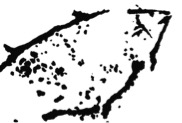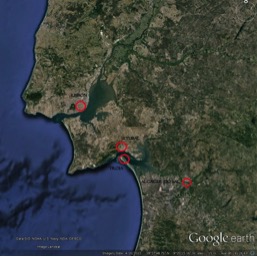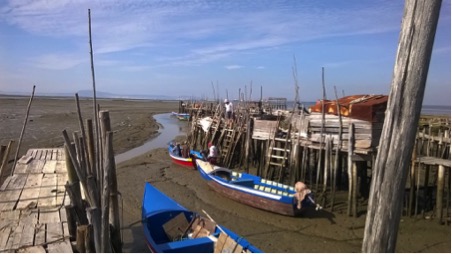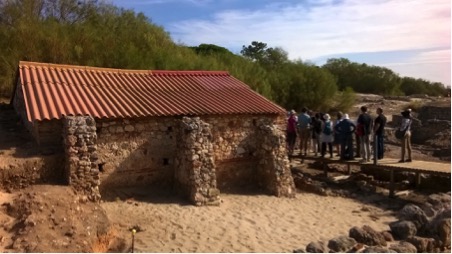Every year the Department of Classics supports students through generous travel awards. Here is a report from our doctoral researcher Lee Graña:
This autumn Lisbon was host to the 18th biennial meeting of the Fish Remains Working Group (FRWG), a conference attracting historians, archaeologists and ichthyologists from across the globe, with a common passion for the study of fish and fishing. Following my successful application for the Alan Wardman Travel Award I was able to attend the conference and following field trips to several important sites in the districts of Lisbon and Setubal. The insight into ongoing studies of ancient fisheries, alongside the contacts made, have made this a fruitful and influential experience.
The conference took place at the Lisbon Geographic Society over three days. There were nine diverse sessions promoting a rich interdisciplinary approach to the subject and therefore providing invaluable information on potential theories and approaches. Session Three: ‘Roman Fisheries and Fish Products’, highlighted the ongoing debates on the subject of Roman fish-processing. There continue to be various contrasting interpretations of the literary evidence, concerning the methods of salting fish for dried or sauce products. It seems the archaeological evidence from the Southern Iberian coast continues to be highly influenced by the classical authors and our interpretations of these texts. In addition to this debate, archaeological discoveries throughout Europe are revealing a complex structure of Roman fisheries with diverse approaches to the exploitation of freshwater and marine resources. I had a great opportunity to discuss this evidence further with current researchers and specialists in the field, while receiving invaluable feedback on my research. Several contacts were made with potential case studies for ongoing or future research.
The field trip started at the port of Setubal with a boat journey on a seventy-year-old ‘galleon’, originally used to transport salt. Accompanied by curious dolphins, we followed the Sado estuary to where it meets the Atlantic Ocean and where the coastline is strewn with over two thousand years of manmade structures applied to the exploitation of marine resources. To date, many traditional fishing methods continue to be used, avoiding the influences of modern fisheries (the photograph above was taken at the quays of Carrasqueira, demonstrating the influence of the tidal estuary and the continuity of traditional fisheries).
The following day we visited the site of ‘Alcacér do Sal’ (The Salt Fortress). For close to three thousand years this site has acted as an acropolis overlooking the Sado river and its vast fertile banks where endless fields of rice are now cultivated, but where once salt pans stretched as far as the eye could see. The use of this resource for the production of salted fish products at an industrial scale may have its origins in the Phoenician occupation of southern Iberia, reaching its zenith during the Roman Empire. Alcacer is now a hotel and museum encompassing the medieval nunnery, which subsequently encompasses a 13th century Moorish fortress, in turn built on Roman foundations. However, not all of the Roman sites in the region have such a complex stratigraphy. The following visit was to the Troia Peninsula, where one of the largest Roman fish processing sites has survived, buried under vast sand dunes.
It is believed that fish sauce would have been produced at these workshops by mixing vast amounts of locally sourced fish with the salt being produced at Alcacer. The tanks vary in size, though the largest examples can reach 7 x 4 x 2m with a capacity of over 65m³. Twenty-five workshops (structures with one or more salting vats) have been identified at Troia, though much remains buried. Future excavations may provide more evidence on the capture and processing of local marine resources (the image below is a southern view of Workshop 1 and the FRWG team).
The final trip was to the ‘Merrcado do Livramento’, a local bazar rivaling the largest supermarket in Setubal. One third of the market was dedicated to selling fish, containing hundreds of species from diverse environments. From finger length anchovies to 2m long sword fish, the market provided us with fresh examples of the species identified in the archaeological record, as well as supper for the evening.
Though many countries contain archaeological examples of Roman fisheries, or are the subject of Roman literary texts on local fish consumption, Portugal provides a unique case study of a country which perpetuates the importance of local marine resources, as significant to the local economy and population today as it likely was two thousand years ago. The culture remains immersed and dependent on marine resources, combining ancient tradition with modern advances in a way that promotes the continued exploitation of local supplies, rather than their substitution for cheaper resources in international waters (as is the case in many European countries). It was therefore an ideal setting for the FRWG and an inspirational location for my research.
I would like to thank our host, Sónia Gabriel and the rest of the organizing committee for such an incredible experience and enriching conference. I would also like to thank Professor Annalisa Marzano and the Classics department for their support in making this trip possible.






